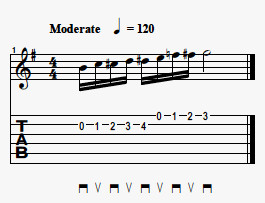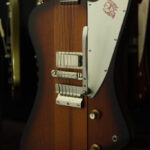In this lesson, we’re diving deep into the Chromatic Scale On Guitar. Understanding and practicing the chromatic scale is fundamental for any guitarist looking to enhance their technique, ear training, and overall musicality. We’ll start by defining what a chromatic scale truly is, then explore a practical and common shape to play it across the fretboard. Finally, we’ll touch upon how you can apply this knowledge musically with a simple lick example.
So, what exactly is a chromatic scale? Simply put, a chromatic scale is a musical scale that includes every single note within an octave. Unlike major or minor scales which have specific intervals and gaps, the chromatic scale moves in half steps (semitones) from one note to the next. This means if you were to play every fret in succession starting from any note on your guitar, you would be playing a chromatic scale. For instance, beginning on the open E string and playing each fret up to the 12th fret E would be a chromatic scale in action. It encompasses all twelve tones of Western music within that octave, providing a complete palette of sounds.
Why is learning the chromatic scale important for guitarists? Firstly, it’s an incredible warm-up exercise. Running through chromatic scales helps to synchronize your left and right hands, improving dexterity and finger independence. It also serves as a fantastic fretboard mapping exercise, familiarizing you with every note in a given area. Beyond technique, understanding the chromatic scale is crucial for ear training as it exposes you to all possible intervals. Musically, while not often used as a melody itself, chromaticism (the use of notes from the chromatic scale) adds color and interest to solos, fills, and compositions. You’ll find chromatic notes used in various genres, from blues and jazz to rock and classical music, to create tension, smooth transitions, or add a unique flavor.
Now, let’s learn a useful and common chromatic scale shape that spans all six strings of your guitar. The diagram and tablature provided below illustrate this pattern clearly. If you’re new to scale diagrams, you can learn how to read them here.
Start by playing the open low E string. Then, using your first, second, third, and fourth fingers, play the 1st, 2nd, 3rd, and 4th frets respectively on the low E string. Repeat this same four-fret pattern on the A and D strings. When you reach the G string, the pattern slightly adjusts. Play the open G string, followed by only the 1st, 2nd, and 3rd frets with your first, second, and third fingers. Finally, revert back to the initial four-fret pattern for the B and high E strings. This consistent pattern makes the shape relatively straightforward to memorize and execute. Practicing this shape ascending and descending across the fretboard is an excellent daily exercise to improve your technique and warm up before playing.
 Chromatic Scale Lick
Chromatic Scale Lick
You might be thinking, “Okay, I can play a chromatic scale, but how is this musically relevant?” That’s a valid question! To demonstrate its practical application, here’s a lick that incorporates a small segment of the chromatic scale. This lick serves as an example of how you can weave chromaticism into your playing to add interest and flair. Let’s imagine a simple chord progression in the key of G: G C G D G C G D G. We’ll use this lick to “tag” or conclude a phrase within this progression, giving it a bluegrass or country vibe. The tab and notation for this lick are provided for your reference. If you need a refresher on reading guitar tabs, you can find a guide here!
To put it in context, play the progression: G C G D G C. The chromatic lick comes in immediately after the second C chord in the sequence. The rhythm of the lick is based on sixteenth notes, except for the final note which is a half note for emphasis. Begin by playing the open B string. Next, play the 1st, 2nd, 3rd, and 4th frets on the B string using your first, second, third, and fourth fingers in succession. Then, move to the open high E string and play it. Finally, play the 1st, 2nd, and 3rd frets of the high E string with your first, second, and third fingers. That’s the entire lick! In the example, this lick is played over the final G, D, and G chords of the progression, though you might not hear those chords distinctly in the video demonstration focusing on the lick itself.
In conclusion, the chromatic scale is far more than just a technical exercise. It’s a fundamental building block for understanding music theory on the guitar, improving your technique, and adding a unique dimension to your musical vocabulary. Use the scale shape provided to strengthen your left and right hand coordination and explore the lick as a starting point to inspire your own creative chromatic licks and musical ideas. Practice the chromatic scale regularly, and you’ll find it unlocks new possibilities across your guitar playing journey.

